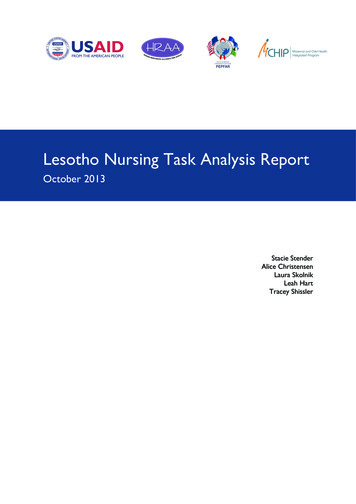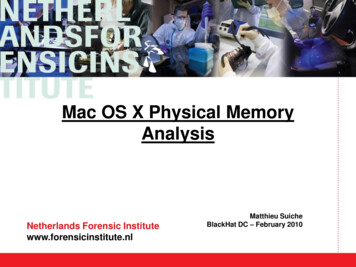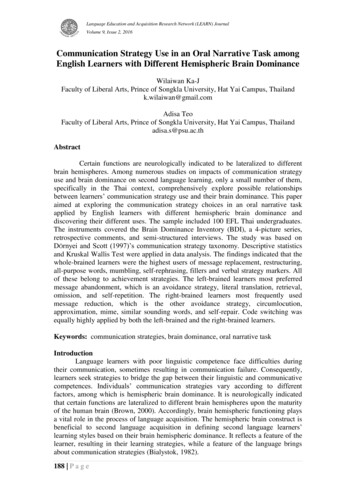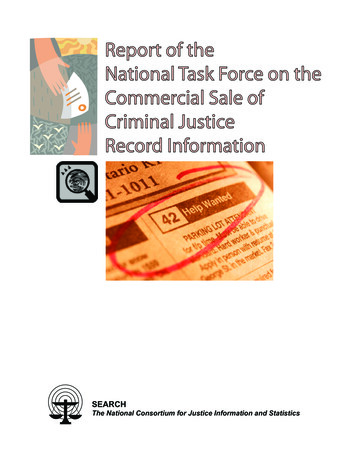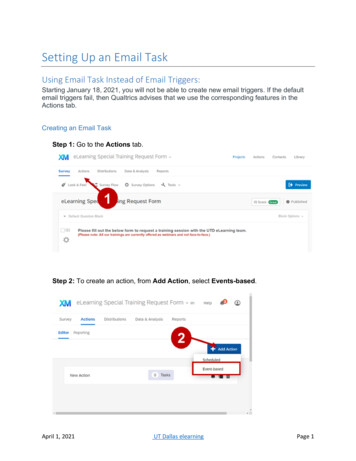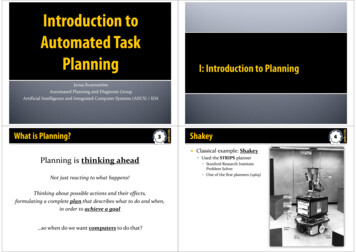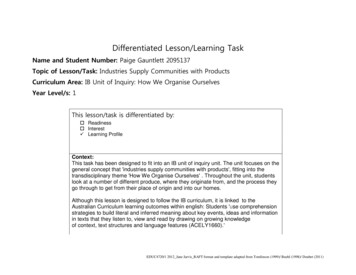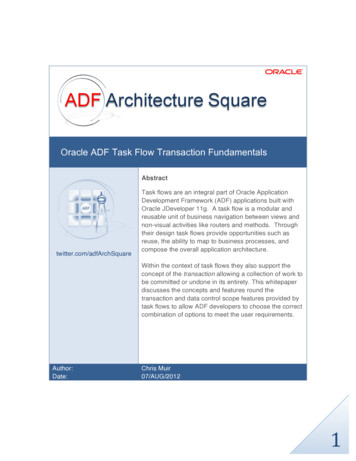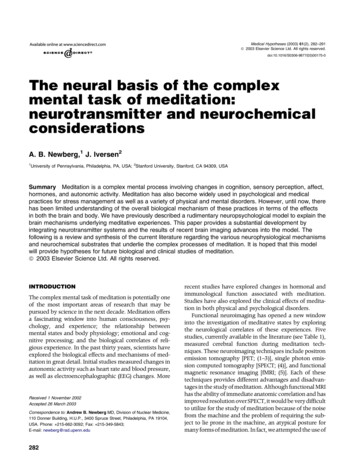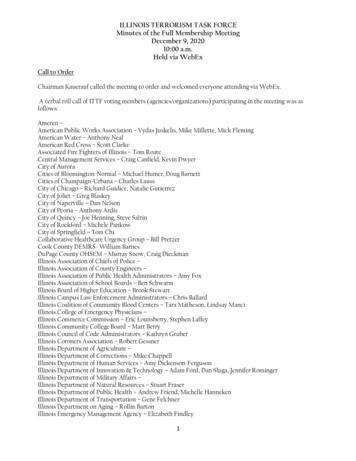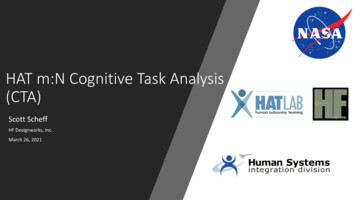
Transcription
HAT m:N Cognitive Task Analysis(CTA)Scott ScheffHF Designworks, Inc.March 26, 2021
Cognitive Task Analysis Study Overview Goal - understand the capability of the NASA-Jobym:N Tactical Operator (TO) interfaces to supportTOs supervising up to 100 independent smallunmanned aerial systems (sUAS) Introduction - Use incident-based cognitive taskanalysis methods with aviation SMEs who haveserved in analogous roles:–Examine cognitive support provided by m:NTO interface in simulations that included n 12and n 100 scenarios–Elicit tacit aspects of expertise and complexmission settings related to command ofmultiple aircraft with relevance to the TO roleand might require support from the m:N TOInterface Analysis– Identify interface elements that were andwere not supportive– Articulate cognitive requirements associatedwith command of multiple aircraft andmission contexts that increase complexity forthe human operator2
CTA InterviewAdapted from Applied Cognitive Task Analysis (Militello & Hutton, 1998) Interviews occurred over two 1-hour sessionsSession 1DemographicsSimulation 1: n 12 sUASSession 2Simulation 2: n 100sUASTask DiagramKnowledge Audit All interviews were conducted remotely using GoToMeeting with the interviewer,interviewee– Some interviews also included a note-taker and/or second interviewer Sessions were video-recorded and transcribed using an AI transcriber3
CTA Interview Each simulation included three events: nominal start, caution/warning event, and complexcaution/warning event Events were followed by a series of questions to understand the interviewees assessmentof the situation, potential actions, alternatives, communication needs4
CTA Interview Each scenario included follow-on questions based on hypotheses about how the userwould be supported by the interface Hypotheses–––––––Interviewees would be able to supervise 100 assetsInterviewees would understand alerts and know what steps to takeInterviewees would choose to drop the payloadInterviewees would want to customize displaysInterviewees would want to handoff off-nominal assetsInterviewees would accept system recommendationsInterviewees would use the Recently Viewed Assets ixedFalse5
CTA InterviewTask Diagram Interviewee asked to reflect on rolewhere they had control of other aircraftand react to unexpected events Decompose task into three to sixsubtasks Identify subtasks that required mostexpertiseKnowledge Audit Reflecting on that same role, asked toprovide an example for each of threecognitive probes about an aspect ofexpertise– Noticing– Big Picture– Job Smarts Follow on questions regarding whatmade this task hard, and cues andstrategies6
CTA Interview: Interviewees Aviation subject matter experts in analogous roles: experience commanding or directing multipleaircraft simultaneouslyRolePart 107 Certified UAS operatorPilot (military, commercial, or private)MQ-1 senior mission intelligencecoordinatorAir Traffic ControllerN2*313***Note: one participant had both experience as a Part 107 Certified UAS operator and amilitary/commercial pilot**Note: one participant had both experience as an air traffic controller and a pilot7
CTA Analysis: User Interface Data set: 16 video recordings, transcripts, 8 taskdiagrams, 8 knowledge audit tables Qualitative data analysis tool: Dedoose Version 8.0.35– Transcripts uploaded to Dedoose for qualitative dataanalysis– Fixed coding scheme to identify content about specificinterface elements– Flexible coding scheme to identify other content relative toCTA objectives– Example codes: Alerts, Asset Telemetry, Locate Uber Driver,Management by exception, Desired Feature, Mapfilters/layers8
CTA Analysis: Cognitive Requirements Cognitive requirements table (see excerpt below) draws primarily from– Task diagram and knowledge audit tables– Interviewee statements on past role during simulation interviewNameWhat makes this hard?CuesStrategiesVignettePredictingmissionflow overtime(on time,late)Mission flow isaffected byindependent missionattributes such asthe amount of cargo,or potentialbottlenecks in thesystem from outsideforces that areunaware of theirimpact.Visually inspectingthe size of theluggage cart, theamount of groundtraffic, theorientation ofaircraft and howaircraft are lined upto land or takeoff.Understandingweather impacts.Early on, get stopwatchestimates of task times tounderstand normal variationand abnormal. Understandingthe steps in the workflow.Knowing typical events orflow specific to area ofresponsibility. Widening thefield of view on displays tosee what coming into sectorto affect your operationsThere is a certain pattern andpace to getting an aircraftloaded on time. seeing howclose they were going to putan arrival and departuretogether, especially at the start.I think that expertise to pullthose arrivals and departuresapart by a good extrafive minutes to give ourselvessome time to kind of get throughthe process the first time.9
CTA Analysis: Complexities Analysis Mission or context-specific examples that increase task complexity Drawn from complexities described by interviewees during the simulation or specificlived experiences Examples:–––––Aircraft controlled landing in uncontrolled areaPayload too heavy for airframeBattery status inaccurateAutomation failure undetected and unrepresented to the TOCongested intersection point10
Findings: UI OverviewDedoose Code Cloud Depicts frequency of codes representingfeatures, tasks and concerns Guided organization of findings11
Findings: UI Interface ElementsDesired Features Screen within a screen Micro/macro view Safe landing locations with real timevideo of the area Excess payload weight Amount of delay Representation of vehicle connectivity Phase of flight on mission timeline Resize chat and asset telemetry asneeded Auto resolve actions Select sUAS on map and see additionalinformation including telemetry At a glance representation of recentlyoff-nominal sUAS TSD new chat notification Battery information Sparklines for planned and actualaltitude12
Key Findings: UI - TSD Screen within a screen (so users can see the full map but when desired zoom in on aspecific grid or map tile to get a better view of a particular sUAS). Micro/Macro view (helpful when trying to see all assets, including those that mightbe out of the current view).Screen Design Mockup to Illustrate a Micro/Macro View Concept13
Key Findings: UI - TSD The central display, also known as the TSD, was considered by all but one intervieweeto be the cornerstone of the interface. Users stated they spent between 60-80% oftheir time looking at this display followed by the Telemetry screen, Chat screen, andthen the Timeline screen.– Percentage of time working with the TSD did reduce as more assets (and more assets in offnominal states) were added to the map and management by exemption came into play– Participants still looked at the TSD the majority of the time however14
Key Findings: UI – TSD and Color Coding There was some concern over the colors used in the coding scheme as well as the useof dark colors over a dark map While interviewees could easily ascertain that red signaled a warning and yellow acaution, they were less sure of the dark blue vs. lighter blue for sUAS icons androutes. White routes over grey streets was also a complaint“The thing that immediately jumps out to me is, it's a little hard for my eyes to dealwith the blue, with the black. I would want to make the targets more salient. Sowhatever the options were, my goal would be making sure that the background didn'tmask the targets and the information display.” – Interviewee 8, ATC15
Key Findings: UI – Weather Layer Interviewees wanted access to weather information, either as part of a brief, and/or as partof a map filter. Weather especially came up with the payload scenario when intervieweeswere trying to troubleshoot why an asset could not reach its designated altitude.– Consider incorporating weather patterns, wind speed and heading, and barometric pressure as amap layer.“I’m thinking that wind measurements should be on the screen so that I can know what’s goingon with wind and weather.” - Interviewee 6, ATC“Weather observations should be given to me in my brief.” - Interviewee 6, ATC“If I saw an anomaly I might flip on the weather and see if there was a non-loss event that justhappened with the weather.” - Interviewee 1, Mission Coordinator“I’d usually use just general forecasts from like Accuweather, and then we had a local weatherstation as well that was showing wind speed and barometric pressure.” - Interviewee 3, Pilot16
Key Findings: UI - Alerts Interviewees were challenged with understanding some of the terminology used in the alerts, understanding what stepsthe auto resolver was going to make, how to get more information on an alert, and how to take next steps to dealingwith the alert. The prioritization of options in the alert was not always liked. For the payload issue forexample, the first option of abandoning (releasing) the payload was either the lastresort or would not be considered by most interviewees and as such interviewees feltthat option should be listed at the bottom of the message, or not at all.“I need additional information to interpret, to start augmenting my decisionmaking.” - Interviewee 8, ATC“It says auto resolving and asset and timeline, which is super unsatisfactoryfor me because I don't know what auto resolving means. I'm not getting anyadditional information about this. There's too many aircraft for me to have anidea of what everyone's flight plan is. When something like this pops up, Iwould like the information so I know, OK, payload, issue. Maybe, you don'thave more information on the issue but I would certainly want as much asthere was. Hopefully it's more than auto resolving and a timeline. That's nice,but maybe some checklist tailored to the issue, especially if this is a thing thatcomes up often, so at least I have some reference to it.” - Interviewee 8, ATC17
Key Findings: UI – Altitude Status Interviewees found the altitude sparkline very important but also felt it wasn’tenough. The dot representing where the asset was, was just a single snapshot intime. Interviewees wanted to see trends.“If there was a planned elevation, then maybe I would understand that here’s the path,and here’s where they are, and if they’re deviating higher or lower.” - Interviewee 1,Mission Commander18
Findings: Cognitive Requirements Facilitating mission flow– Recognize and foresee potential bottlenecks, conflicts, and barriers to mission flow Importance of weather Known set of abnormal events– Initiate corrective actions early Predicting automation in context– Robust mental model of sUAS operations even when interface is not transparent– Calibrating trust in automation Maintaining big picture perspective– Use knowledge of aircraft type and capabilities, weather, mission, location, adjacent aircraft– Understand second and third order effects– Operators force themselves to maintain scan even during emergency/off-nominal19
Findings: ComplexitiesNon-exhaustive categorized examples of complexities, useful for hypothesis testing andscenario design: sUAS air vehicle and payload – controlled and uncontrolled landings (injury, propertydamage), battery state, in-flight automation failure Environmental conditions - fixed and mobile vertical obstructions, weather Food delivery service - arising from the nature of food delivery sUAS/Driver infrastructure - arising from n sUAS operations, necessary interfacebetween sUAS and driver, or sUAS and ground personnel TO personnel - TO behaviors or support to the TO20
Next Steps Iterate future designs and user feedback, including more in-depthnavigation and asset handoff exploration Google Forms for a deeper dive on Handoffs UsabilityHub.com survey to capture user interactions and feedback21
Questions or Comments?scottscheff@hfdesignworks.com22
CTA Interview Each simulation included three events: nominal start, caution/warning event, and complex caution/warning event Events were followed by a series of questions to understand the interviewees assessment of the situation, potential actions, alternatives, communication needs 4
